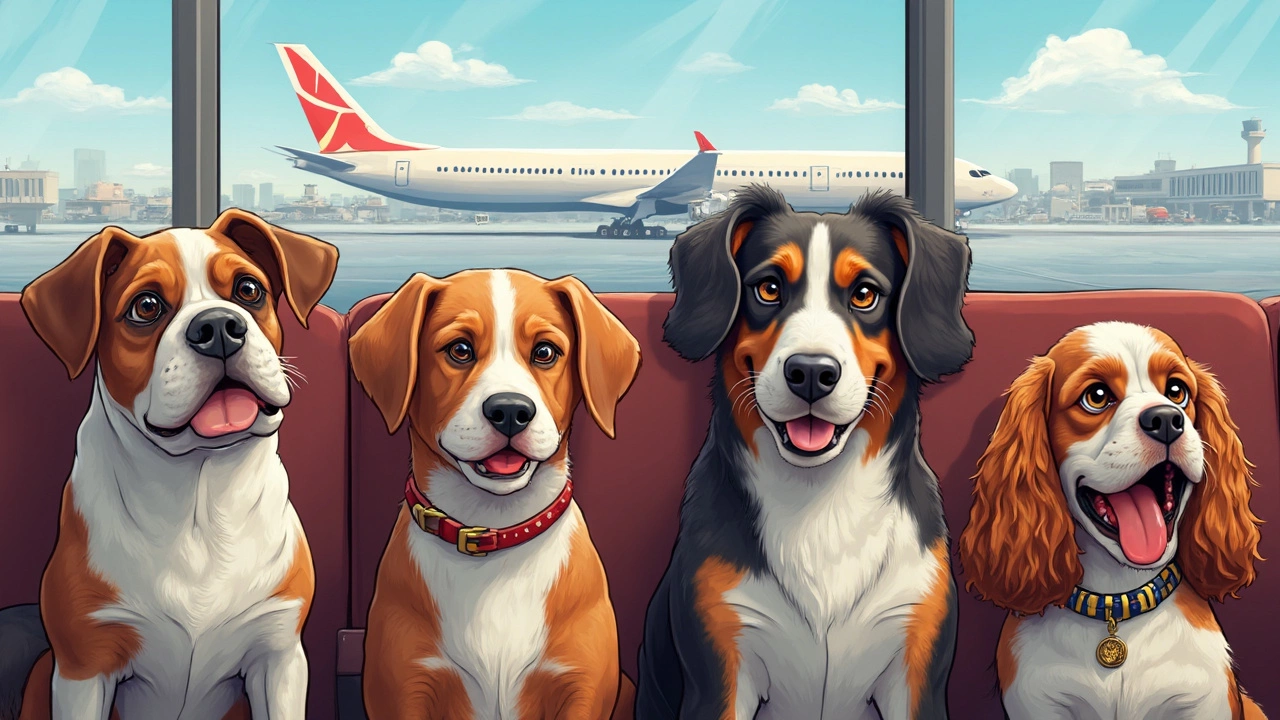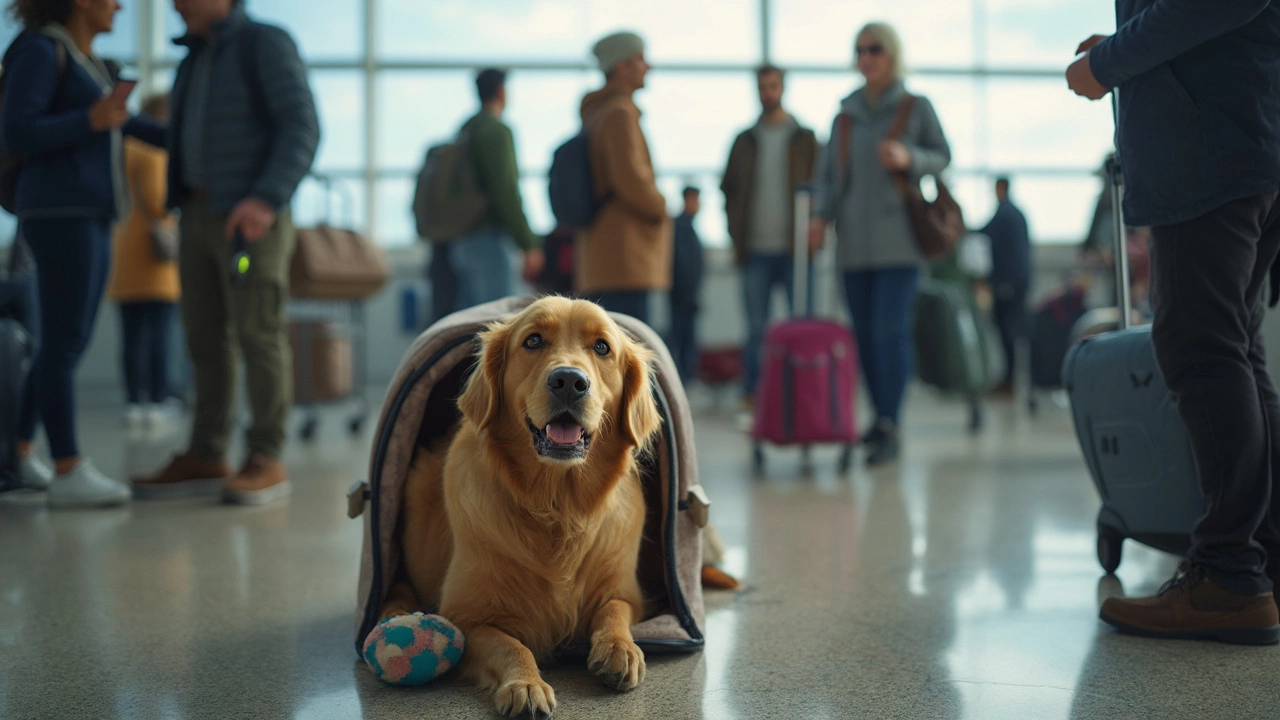Most people think flying is just uncomfortable for us, but for dogs, it can be a real challenge. Shoved into a crate, hearing strange noises, surrounded by new smells, and sensing your own nerves—no wonder dogs can get stressed out at 30,000 feet.
For a dog, a trip in the sky is very different from their daily routine. They lose familiar scents, can't stretch out, and may even sit alone in cargo far from you. Fear triggers their bodies the same way as it does with fireworks or thunderstorms—heart rate jumps, panting starts, and some dogs even drool or shake. It's tough because dogs can't say they're anxious—you have to look for small clues.
But don't panic. Knowledge helps a ton. Knowing what your dog might go through is the first step to helping them out. There are real ways you can prep before boarding day so things go smoother for both of you. Next, let's look at why some dogs get super stressed about flying, while others seem to shrug it off.
- Why Flying Is So Stressful for Dogs
- Recognizing and Measuring Dog Stress During Air Travel
- Breed, Age, and Health: Who Gets Hit Hardest?
- Preparing Your Dog Before Takeoff
- Essential Tips for Safer, Calmer Flights
Why Flying Is So Stressful for Dogs
Imagine suddenly being locked in a noisy box, rolled around by strangers, and separated from everyone you trust. For dogs, that’s what air travel feels like. Airplanes come with a ton of unfamiliar sights, smells, and sounds. Airports are hectic—there’s beeping machines, rolling luggage, and new people everywhere. Dogs rely a lot on routine and familiar cues, so flying yanks them way out of their comfort zone.
The biggest stress trigger? Being separated from you, their person. If your pup has to fly in cargo, they don’t just miss you—they also end up surrounded by strange pets and loud machinery. The stress hormone, cortisol, can spike, causing a racing heart, upset stomach, trembling, and sometimes even accidents in the crate. Some dogs, especially small or anxious types, feel this stress even if they’re flying in the cabin right at your feet.
“Many dogs experience significant anxiety when flying, especially when confined in unfamiliar environments. Cargo holds can be particularly challenging due to noise, temperature changes, and lack of human comfort,” says Dr. Emily Blackwell, a well-known animal behaviorist from the University of Bristol.
It’s not just about nerves, either. Dogs have a strong sense of hearing, so every shift in engine noise, overhead announcement, or clanging cart is extra intense. Changes in air pressure can bother their ears just like ours, and some dogs may even have trouble breathing, especially flat-faced breeds like French Bulldogs or Pugs.
- Dog travel safety is at risk if the airline mishandles pets or doesn’t keep cargo temperatures right. There have even been rare cases of lost or injured pets—one more reason many owners worry.
- Water and restroom breaks are almost impossible once your dog is in their crate, making long flights especially tough.
- Even the best crate can feel like a prison, not a den, if a dog hasn’t gotten used to it ahead of time.
So, flying stresses out most dogs because it flips their world upside down. It’s noisy, confusing, and lonely. That’s why a little prep (and understanding what your dog is dealing with) can make all the difference.
Recognizing and Measuring Dog Stress During Air Travel
Dogs aren’t shy about showing stress, but it takes knowing what to look for. During air travel, many dogs show clear physical signals. They might pant more than usual, especially if the plane's noisy or if the temperature is off. Watch for drooling, whining, barking, or even trying to dig inside their crate. Some dogs will shed more—random, but true—and others get a little shaky or rigid.
Vets use these visible clues, but there are other ways stress reveals itself. The American Veterinary Medical Association highlights behaviors like hiding in their crate’s corner, refusing food or water, and pacing in place. You might also notice classic signs like wide eyes, pinned-back ears, or a tucked tail. In one 2022 study on dog travel, researchers tracked heart rates and found that many pups experience a big jump from the minute their crates get moved toward the plane, not just during the flight itself.
If your dog tends to get anxious even on car rides, expect a bigger reaction in the air. Dogs used to loud noises or crate time at home generally do better, but even the calmest dog can get rattled by turbulence, takeoff, or new smells in the cabin. Keep in mind, sedation is not recommended by most airlines—it can actually make symptoms harder to spot and make things worse.
- Look for extra panting or drooling—these show up the fastest.
- Watch their eating and drinking: many nervous dogs just won’t touch their food.
- If you hear whining, barking, or even silence from a usually noisy dog, pay attention. Sudden changes matter.
- Track bathroom habits. A lot of stress means more accidents, or the opposite: not going at all, even if they should.
If you’re really worried, some vets offer wearable monitors for heart rate and breathing that are made just for dogs, but honestly, paying attention is your best tool. Snapping a quick video of your dog's travel behavior can help your vet troubleshoot before your next trip, too.

Breed, Age, and Health: Who Gets Hit Hardest?
Not every dog handles flying the same way. Some just aren't built for it, and there are a few things that can make air travel riskier or more stressful. Here’s what you really need to watch for when it comes to dog travel by plane.
Brachycephalic (Short-Nosed) Breeds
Dogs like Bulldogs, Pugs, and Boston Terriers really struggle with plane rides. Their squashed faces make breathing harder, especially when they’re stressed or when the temperature fluctuates in cargo. That’s a big reason many airlines restrict these breeds, especially for longer flights.
Older Dogs
Age plays a role. Dogs over 7 (for small breeds) or 5 (for big breeds) face more health risks when flying. Seniors get cold easier, recover slower from stress, and if they have arthritis, being stuck in a cramped crate for hours only adds to their misery.
Puppies
Puppies under 12 weeks aren’t great air travelers either. They’re sensitive to temperature swings, and their immune systems aren’t strong yet. Some airlines actually ban really young pups from flying for this reason.
Dogs With Health Issues
If your dog has heart trouble, breathing problems, or anxiety, flying can make things worse. Even minor issues like motion sickness or past trauma from travel can blow up mid-air. If you’re unsure, get your vet’s take long before booking a ticket.
How Different Dogs Cope
| Dog Type | Stress Risk Level | Extra Airline Restrictions? |
|---|---|---|
| Brachycephalic breeds | Very High | Yes |
| Senior dogs | High | No (but vet check required) |
| Puppies (<12 weeks) | High | Yes |
| Dogs with chronic health issues | Very High | Yes/Case-by-case |
| Healthy adult dogs | Moderate | No |
Some dogs—like working breeds (Labs, Shepherds)—tend to be more adaptable, but even they can hit their limits. If your pup has flown before and did fine, that’s a plus. But don’t assume the next flight will be a breeze if their health or age changes.
What Can You Do?
- Ask your vet for a pre-flight health check and get advice tailored for your dog's breed and age.
- Check your airline's rules—they change often and can be strict about certain breeds or young pets.
- If your dog has special needs (medication, mobility stuff), plan ahead and tell the airline early.
Being honest about what your dog can handle makes travel safer and less stressful for everyone. Taking shortcuts or ignoring these factors can put your pup at real risk in the air.
Preparing Your Dog Before Takeoff
Getting your dog ready for a flight isn’t just about booking their spot. It’s about making sure they’re comfortable, safe, and as relaxed as possible before those wheels leave the ground. Dogs can sense your vibe—if you’re stressed, they’ll pick up on it. The best prep starts days, sometimes weeks, before flying.
Start with crate training. Airlines only let you fly with specific crates, and your dog needs to see it as a safe, familiar space—not a punishment. Training usually takes about two to four weeks for most dogs. Leave the crate out at home with the door open. Toss treats inside. Feed your dog meals there. You want your pup thinking, "Crate = good stuff." When the travel day comes, it's less of a shock.
Next up: book a vet check. Most airlines require a health certificate that’s less than 10 days old. But it’s more than paperwork. You want to check if your dog is healthy enough to fly. Dogs with heart, breathing, or anxiety issues might not be good candidates. Your vet can also help decide if calming meds or supplements could help, but steer clear of anything without pro advice. Sedatives are dicey—they’ve been linked to breathing problems and heart risks during flights.
Before you go, update your dog’s microchip info and add a clear ID tag to their crate and collar. Lost pets in airports are rare, but every year, airlines report mishaps. A 2023 DOT report showed 0.76 pets lost per 10,000 transported, mostly during layovers. Simple ID makes reunion a million times easier.
- Take practice trips—car rides or short stays in the crate to mimic the journey. If your dog’s never been to a loud place, visit busy spots together.
- Skip food 4–6 hours before takeoff (it helps with nausea and bathroom needs).
- Pack a bag with basics: leash, favorite toy, water, vet records, and poop bags.
- Bring a small blanket or t-shirt with your scent for calm comfort in their crate.
| Rule | Cabin | Cargo |
|---|---|---|
| Max Crate Size | 18 x 11 x 11 in | Varies, up to 40 in |
| Health Certificate Needed | Yes (within 10 days) | Yes (within 10 days) |
| Allowed Breeds | No "snub-nosed" dogs (like bulldogs, pugs) | Breed restrictions common |
| Pet Fee | $95–$200 | $200–$500 |
Feels like a lot? The more you prep, the less stressed both you and your pup will be. Dogs who recognize their crate, have a familiar scent nearby, and skip the pre-flight breakfast usually travel with fewer problems on board. Dog travel isn’t easy, but planning ahead makes it manageable.

Essential Tips for Safer, Calmer Flights
If you want your dog to have a smooth trip, the way you prepare matters more than anything. Over half of dog owners say they worry more about their pet’s flight than their own—and not without reason. But when you plan it out, you drop a lot of the risk and stress for your furry buddy.
- Dog travel crate choice is huge. Always go for an airline-approved, hard-sided crate. It should be big enough for your dog to stand up and turn around, but not so big they get jostled around, according to the International Air Transport Association (IATA).
- Get your dog used to the crate well ahead of time—weeks, not days. Toss treats in, feed them inside, or let them chew a toy in there. The idea is making the crate a safe little “den.”
- Book a direct flight when you can. Every connection or transfer cranks up your dog’s stress. Direct flights mean fewer bumps, less noise, and a faster end to the trip.
- Ask your vet about anti-anxiety meds or calming supplements. Never sedate your pet on your own; only your vet should recommend it. The American Veterinary Medical Association says many sedatives can mess with breathing during flights.
- Stick a piece of clothing with your scent in the crate. Don’t use a big blanket—dogs can overheat—but a worn T-shirt can actually chill them out.
- On the morning of the flight, exercise your dog really well. A good run or long walk makes them tired in the best way and helps them stay relaxed.
- Always keep ID tags updated and include a copy of their rabies certificate and any airline-required paperwork attached to the crate.
Worried about what can go wrong? Here’s how often airlines have reported pet incidents in the last few years, according to the U.S. Department of Transportation’s Air Travel Consumer Reports:
| Year | Pets Transported (USA) | Incidents (Death, Injury, Loss) |
|---|---|---|
| 2022 | 188,223 | 19 |
| 2023 | 204,405 | 15 |
Incidents are rare but still possible, so don’t skip double-checking crate latches and checking airline rules. Small dogs in-cabin usually face far fewer issues than those flying cargo, but size and breed can limit your options.
Every airline is different. Some allow certain breeds, others don’t. Ticket agents rarely know all the details, so always call ahead, read up on their pet policy, and ask about summer or winter travel bans. If you take proactive steps, you stack the odds in your dog’s favor for a much easier journey.
